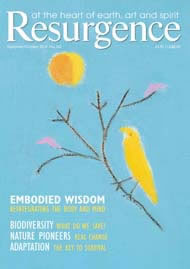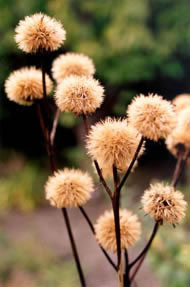The autumn equinox sees the end of the growing season as plants die back and decomposition takes over. While the Earth retains summer’s warmth for a while longer, roots can continue to grow, which means many of the winter greens can carry on developing through the back end of the year. But at the surface, vegetation begins to break down and it is this natural activity we can utilise to make our compost heap. Perhaps the most important installation in any garden and sometimes treated as a dump for unwanted material, it is in fact the guarantee of future fertility.
If we left everything where it fell, leaves, stems and even logs and branches all would rot down in time, and I do take advantage of this in large areas of our garden with interesting results as environments mutate. The shrubs and weeds make their own alliances, evolving in creative symbiosis. In the natural garden, decomposition is a large part of the means whereby habitat is created. Masanobu Fukuoka, author of The Natural Way of Farming, commends all kinds of surface composting, and while acknowledging the value of compost itself, he considers intensive composting unnecessary, as it actually depletes the soil from which the organic material is taken.
However, within the scale of the garden, a compost heap need not compromise the integrity of the site. Bringing all kinds of vegetable matter together into a relatively controlled environment accelerates the process of decomposition, with the maturing time of any heap modified by the initial ingredients and any subsequent turning. Slowest to rot is a wood pile (though poplar’s papery wood soon disappears, while oak, yew and elm will last much longer).
A good heap is made from a blend of woody and sappy material, neither too dry nor too wet, with particles large enough not to deteriorate into a compact, anaerobic mass, and small enough to give the bacteria sufficient surface area to initiate decomposition. My own heap was set up in its present form 20 years ago between sheets of corrugated iron, about six foot square.
The bottom is filled in spring with all the twiggy herbaceous material and small prunings to create an aerating layer. Throughout the summer, weeds, mowings, wood shavings and poultry manure are added, together with the contents of the (urine-only) compost toilet and the top layer of sludge from the septic tank. Covered with a large sheet of black polythene, it soon heats up with bacterial activity. I might stir the top layer to cool things off when the weather is warm, and whilst some gardeners recommend activators, I find that with urine and manure the heap has enough nitrogen to function well. Composting human waste to high temperatures or for at least a year in a domestic heap renders it fit for garden use, and is especially useful where crops provide seed or tuber.
Our compost heap deals with docks, dandelions and couch grass, but bindweed and ground elder are dried and stored in a bin for two years, when they are reduced to papery cords, good for mulching. My mother’s heap, enclosed in a wooden structure, is about a cubic metre in capacity and is fed in careful layers with kitchen trimmings, shredded paper, a few weeds and mowings, together with year-old dry leaves, since leaves need two years to rot and become available to soil life.
Not everyone is keen or able to compost on their own premises, and our district council has established a composting plant hardly a mile from our house, adjoining a landfill site in an old quarry. Keen to know more, I was most courteously shown round the site – the first of its type to be built in the UK and administered by Viridor.
Kitchen waste including cooked food, together with garden waste and cardboard, is thoroughly mixed, wetted and shredded through long, rotating blades, then loaded into a chamber about as big as a squash court. The volumes dealt with could generate too much heat, so air is passed through the heap in order to maintain a temperature of 60ºC for 48 hours. No bindweed would survive this but, more importantly, any pathogens that might be present in food waste will not survive these levels of exposure to heat either. On completion of this cycle the material is emptied and reloaded for a second period of composting to the same temperature, again for 48 hours. The air passed through the heaps is filtered to deodorise it, through a large volume of chipped wood, mostly from the building trade.
Once intensive composting is completed, the heaps stand outside to mature, screened for outsize material, which goes through the cycle again, and is then analysed for potential fertility and appropriate use on local farmland. Some mature compost is always retained to inoculate the next batch of raw material – a little like a sourdough culture! I was impressed with the compact nature of the site, made possible by the manipulation of the material, which can be ready for use within eight weeks. The maturing product on view the day I visited looked relatively dry and fibrous, but evidently easy to handle. The yard had been emptied of all screened compost the day before.
A short walk from the bottom of our garden leads to our village’s composting site, supported by grants from landfill tax (due to the proximity of the aforementioned landfill site), as well as by sales of its excellent compost. Here garden waste is shredded, heaped, turned and sieved to produce a sterile mulch and soil conditioner that is excellent as a surface dressing.
So, whether you chop and turn or simply wait, the compost heap is really an alchemical crucible. What you don’t need today is to become something you cannot do without next month or next year. All that derives from growing matter is never useless: each leaf, stem or twig will become part of the soil again to grow next year’s food, flowers or fuel.








